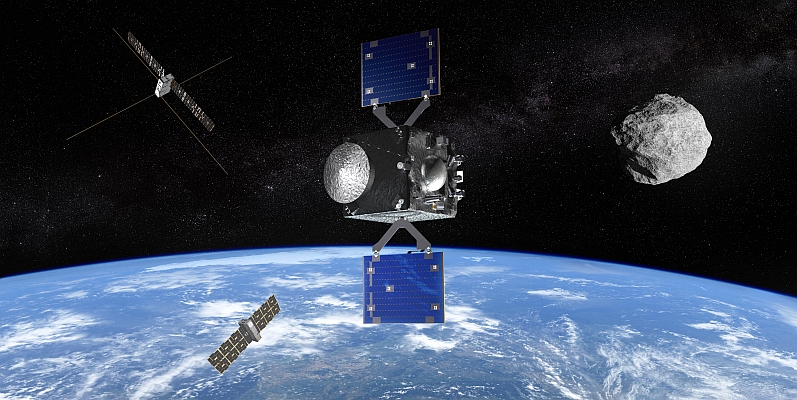
With the initial satellites of the Galileo constellation working well in orbit, it has been decided to end the mission of ESA’s pioneering GIOVE-A navigation satellite. Launched on 28 December 2005, this first experimental satellite performed the vital task of securing the radio frequencies provisionally set aside for Galileo by the International Telecommunications Union.
It also flight-tested Galileo atomic clocks and other equipment in space for the very first time and investigated the radiation environment of medium-altitude orbits, never used before by a European mission.
ESA formally ended GIOVE-A’s mission at the end of June, although it will go on being operated for now by prime contractor Surrey Satellite Technology Ltd of Guildford, UK, to gather radiation data and performance results from a GPS receiver.
“GIOVE-A had a design life of only 27 months, so to continue operating for 78 months is impressive,” said Valter Alpe, managing GIOVE activities for ESA. “In August 2009, the satellite was moved into a graveyard orbit around 100 km above its normal 23 222 km to make way for the Galileo validation satellites. “The first two of these were launched on 21 October 2011 and are performing well, so while GIOVE-A has served ESA well it no longer has a job to do.” Built to a tight deadline by SSTL, GIOVE-A carries a rubidium atomic clock accurate to three seconds in a million years.
On 27 April 2008 it was joined by GIOVE-B, built by an Astrium-led consortium, which carries an even more accurate passive hydrogen maser clock – the first to be flown in space for navigation, accurate to one second in three million years – as well as a second rubidium clock. Operational Galileo satellites carry two pairs of both kinds of clock, for redundancy.
They are very different missions in other ways too. The GIOVEs were modified from existing satellite platforms: a prototype geostationary minisatellite for GIOVE-A, and a commercial French Proteus platform typically used for Earth observation for GIOVE-B.
Galileo satellites are based on an entirely new platform and improved payload, specifically engineered for extremely high reliability, only intended to go into safe mode for a few days over their planned 12 years of operation thanks to a robust design based on reconfigurable redundancy. Even when entering ‘intermediate safe mode’ they can continue to supply navigation signals, although without the usual service guarantee.
GIOVE-B, with an orbital lifetime of 50 months and counting, will be used in payload fine calibration tests this summer with the two Galileo satellites. Then, in September, it will be manoeuvred into a graveyard orbit 300 km higher. At this point, GIOVE-B’s own mission will end. “Early October will see the launch of the next two Galileo satellites by Soyuz rocket from Europe’s Spaceport in French Guiana,” added Valter.
“This will be an important step forward because four satellites are the minimum to perform navigation measurements, so Galileo system testing can proceed.” A follow-up batch of full operational capability Galileo satellites is being built by Germany’s OHB and SSTL, with initial Galileo services forecast to be available by 2014.
ESA extends its navigation lab in readiness for Galileo testing
With the next Galileo launch approaching, ESA has extended its Radio Navigation Laboratory to meet the testing needs of Europe’s own satellite navigation system. Located at ESA’s ESTEC technical centre in Noordwijk, the Netherlands, the laboratory has almost doubled in size, and includes a specialised facility, the PRS Laboratory, suitable for evaluating the single most precise and secure type of Galileo signal, the Public Regulated Service (PRS).
The extended Radio Navigation Laboratory was formally inaugurated on 2 July by Franco Ongaro, ESA’s Director of Technical and Quality Management, Didier Faivre, ESA’s Director of Galileo and Navigation-related Activities, and Riccardo de Gaudenzi, Head of ESA’s Radio Frequency Payload Systems Division.
“Back in the 1980s ESA investigated the potential of the US GPS constellation for docking manoeuvres of the then-planned Hermes spaceplane,” said Director Ongaro. “Today, of course, as ESA’s Automated Transfer Vehicle rendezvouses with the International Space Station it does indeed rely on GPS, and satellite navigation is in widespread use by missions in orbit, just as it is across Earth.
“In the meantime, ESA has joined forces with the European Union to build Europe’s own satellite navigation systems: Galileo should begin to deliver initial services by mid-decade, while the EGNOS augmentation service has already entered use. “ESTEC has been increasingly supporting the development of satellite navigation techniques and technologies. Our navigation facilities have been expanded from a small corner table to a dedicated full-scale facility.
“And today that is enriched by the addition of this secure facility, which will play an essential role in supporting the validation and roll-out of Galileo’s Public Regulated Service, which is one of Galileo’s key services for Europe.” Transmitted on two encrypted signals, PRS offers the highest accuracy Galileo service, with access reserved for governmental organisation such as the police, fire brigade or civil protection.
The PRS Laboratory is a physically and virtually isolated facility where testing can be carried out on a fully secure basis. While employed by Galileo for now, it is able to fulfil the needs of all ESA projects involving secure access to protected equipment or data.
“With the next two Galileo In-Orbit Validation satellites being launched in early October, Galileo is fast taking shape,” said Valter Alpe, Manager of the Galileo Full Operational Capability Satellite Assembly, Integration and Verification. “PRS is a crucial part of Galileo. Today’s addition of the PRS Laboratory is therefore a vital step to support ESA in its role of architect and system prime and enable full verification testing of the entire Galileo system at a single site.”
The facility will also evaluate prototype PRS receivers, helping to enabled high-precision service applications, and investigate anti-jamming and spoofing techniques. “ESA’s first complete worldwide satellite system for end users, Galileo is the biggest single project to which the Directorate of Technical and Quality Management is providing support,” added Riccardo.
“With an extremely tight schedule, a huge and demanding user community and international competition, Galileo is entering into a very critical phase where ESA’s technical capabilities to validate the system will be of utmost importance. This new laboratory extension strengthens those capabilities greatly.”
The Radio Navigation Laboratory investigates the full range of navigation applications, from practical to scientific. An example of the latter is the PARIS mission, now being studied, which would monitor reflected satnav signals to detect ocean storms and even tsunamis.








